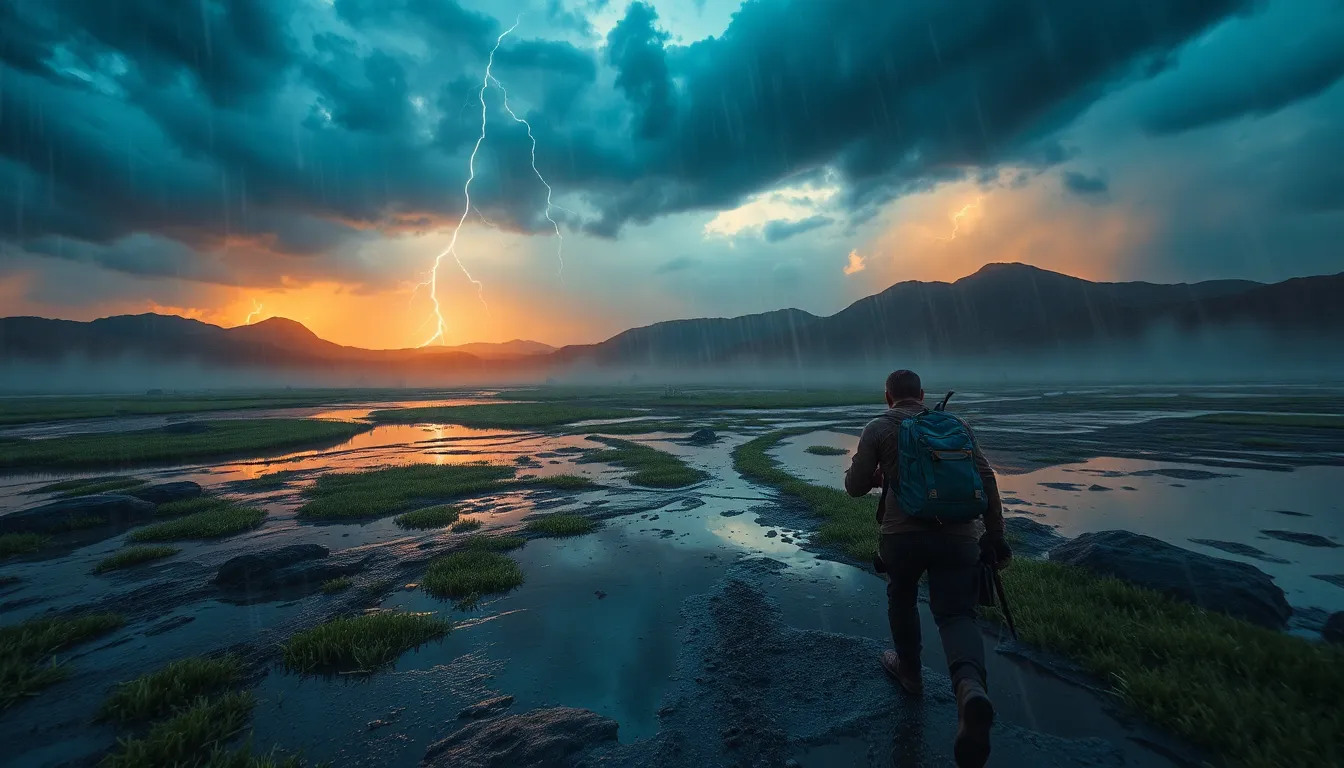Imagine battling fierce monsters while a thunderstorm rages overhead, or navigating treacherous terrains as snowflakes dance around your character. In-game weather effects aren’t just a pretty backdrop; they can transform gameplay into an immersive experience that keeps players on their toes. Whether it’s a sunny day or a torrential downpour, these dynamic elements add a layer of unpredictability that can make or break a mission.
Overview of In-Game Weather Effects
In-game weather effects play a crucial role in enhancing player immersion. Rainfall can limit visibility and dampen movement speed, adding a layer of challenge. Snow often alters terrain dynamics, creating obstacles or providing cover for stealth approaches. Thunderstorms, with their visual and audio effects, can create tension during critical gameplay moments.
Variability in weather patterns introduces unpredictability that affects game strategies. Players must adjust their tactics based on real-time conditions. For instance, heavy wind can affect projectile weapons, leading to misshots or unexpected trajectories.
These elements make each gaming session unique. Developers create diverse weather systems to improve the overall gaming experience. Dynamic weather interactions encourage players to explore different scenarios. They can also change the behavior of non-player characters (NPCs), adding realism and depth to the game world.
Research indicates that players often respond emotionally to these weather changes. Engagement levels increase when the environment reacts to players’ actions. This relationship between in-game weather and gameplay demonstrates the importance of sophisticated weather systems in modern games.
With advancements in technology, the realism of weather effects continues to improve. Sophisticated algorithms now simulate realistic patterns, resulting in visually stunning environments. As players navigate these conditions, the interplay between weather and gameplay creates memorable moments that resonate long after the game concludes.
Types of In-Game Weather Effects

In-game weather effects enrich gameplay with immersive challenges and dynamic environments. Various types of weather systems contribute significantly to player experiences.
Rain and Storms
Rain creates a visually engaging environment, often accompanied by sound effects that mimic real-life rainfall. Heavy storms can trigger flooding, altering movement options and increasing obstacles. Players encounter slippery surfaces, requiring adjustments in navigation. Thunder and lightning enhance tension, adding an auditory element that heightens gameplay intensity. Raindrops can obscure vision, compelling players to adapt their strategies. Dynamic weather patterns may impact resource availability, influencing player decisions during missions.
Snow and Ice
Snow introduces unique gameplay mechanics, such as altering terrain behavior and affecting movement speed. Players may find themselves sinking into deep snow, which slows their progress. Ice can create hazardous conditions, necessitating careful maneuvering to avoid slips. Blizzard conditions can reduce visibility, forcing players to rely on maps or other cues for navigation. Snow also changes NPC behavior, affecting interactions and combat scenarios. In certain games, snow accumulation may affect the environment, requiring adjustments in player strategy.
Fog and Visibility
Fog significantly reduces visibility, creating a sense of uncertainty and suspense. Players might struggle to locate objectives or adversaries, increasing tension during critical moments. The thick mist can lead to surprise encounters, forcing players to remain vigilant. Various games implement fog mechanics that dynamically adjust based on player actions, enhancing realism. This weather effect can also impact sound, causing noises to travel differently, thus altering gameplay strategy. Players often find themselves relying on alternative methods to assess their surroundings.
Impact on Gameplay
In-game weather effects significantly influence gameplay dynamics. Such conditions not only enhance immersion but also introduce new challenges for players.
Player Strategy and Tactics
Changes in weather require players to adapt their strategies. For instance, heavy rain limits visibility, forcing players to rely on sound cues and map knowledge. Players often adjust their tactics in response to storms, utilizing cover more effectively. When icy surfaces appear, movement becomes more challenging, impacting approaches to combat and exploration. Developers design weather effects to enhance unpredictability, ensuring players remain engaged. Tactical decisions shift based on current weather patterns, demonstrating how weather affects overall strategy.
Environmental Interactions
Weather systems create distinct environmental interactions within games. Rain-soaked terrain can slow movement speed, altering navigation routes. Storms may cause trees to sway, impacting players’ line of sight. Snow accumulates, blocking paths and influencing how players manage resources. Changes in weather also affect NPC behavior, as they respond to environmental cues. Fog introduces uncertainty, compelling players to approach situations with caution. Such interactions deepen immersion, making each playthrough unique and memorable.
Popular Games Featuring Weather Effects
Several popular games showcase in-game weather effects, enhancing immersion and gameplay experience. Players often encounter dynamic environments that shift with the weather, adding depth to their adventures.
Game 1: The Legend of Zelda: Breath of the Wild
In The Legend of Zelda: Breath of the Wild, weather plays a crucial role in exploration and combat. Rainfall impacts climbing surfaces, making ascents slippery and challenging. Thunderstorms also introduce the risk of lightning striking metallic objects, prompting players to strategize accordingly. Variations in temperature require players to equip appropriate clothing or consume specific meals to prevent damage. The dynamic day-night cycle further enriches gameplay, creating diverse scenarios for players to navigate.
Game 2: Grand Theft Auto V
Grand Theft Auto V incorporates a robust weather system that enhances realism within its open world. Players experience rain, fog, and thunderstorms, all affecting vehicle handling and visibility. Heavy downpours create puddles that can lead to hydroplaning, altering driving dynamics significantly. Moreover, the presence of fog can obscure important landmarks, requiring players to adjust their navigation tactics. NPCs react to weather conditions as well, seeking shelter during storms, which adds to the immersive quality of the game.
Future of In-Game Weather Effects
Emerging technologies pave the way for transformative in-game weather effects. Developers increasingly rely on advanced machine learning algorithms to create realistic weather systems that adapt and evolve. Improved graphics engines produce stunning visual effects, making storms, rain, and snow more immersive than ever.
Simulated ecosystems represent another significant advancement. These systems allow players to see the consequences of weather changes, influencing both the environment and NPC behaviors. As weather patterns shift, NPCs react dynamically, which adds to the realism and immersion players experience.
Players’ emotional connections to weather effects are likely to deepen as technology progresses. Incorporating weather as a narrative element heightens engagement, turning mundane gameplay into memorable experiences. This emotional resonance becomes a powerful tool for developers seeking to enhance player involvement.
Upcoming games are expected to introduce environmental conditions that challenge traditional gameplay mechanics. For instance, wind dynamics may significantly affect the trajectory of projectiles or vehicle handling, requiring players to adapt strategies on the fly. Continuous advancements in physics engines will further enrich these interactions, providing players with an unprecedented level of realism.
As multiplayer experiences evolve, shared weather dynamics could enhance collective gameplay. Dynamic weather systems could create unified experiences, where players from different regions face challenges together, reinforcing cooperation. Future titles likely embrace this interconnectedness, strengthening the sense of community among players.
Developers may also incorporate seasonal weather changes to diversify gameplay throughout the year. Seasonal transitions can introduce new challenges and opportunities, compelling players to adjust tactics and explore new areas. A gradual evolution of in-game weather effects illustrates a commitment to creating engaging, multilayered gaming experiences.
In-game weather effects are more than just visual enhancements; they fundamentally reshape gameplay and player engagement. By introducing unique challenges and altering environmental dynamics, these effects create immersive experiences that resonate deeply with players. As technology advances, the realism and complexity of weather systems will continue to evolve, promising even more dynamic interactions in future games.
With each new title, developers are pushing boundaries to ensure that weather not only enriches the aesthetic but also influences strategy and decision-making. This ongoing integration of weather into gameplay mechanics will undoubtedly keep players captivated and eager for what lies ahead in their gaming adventures.



